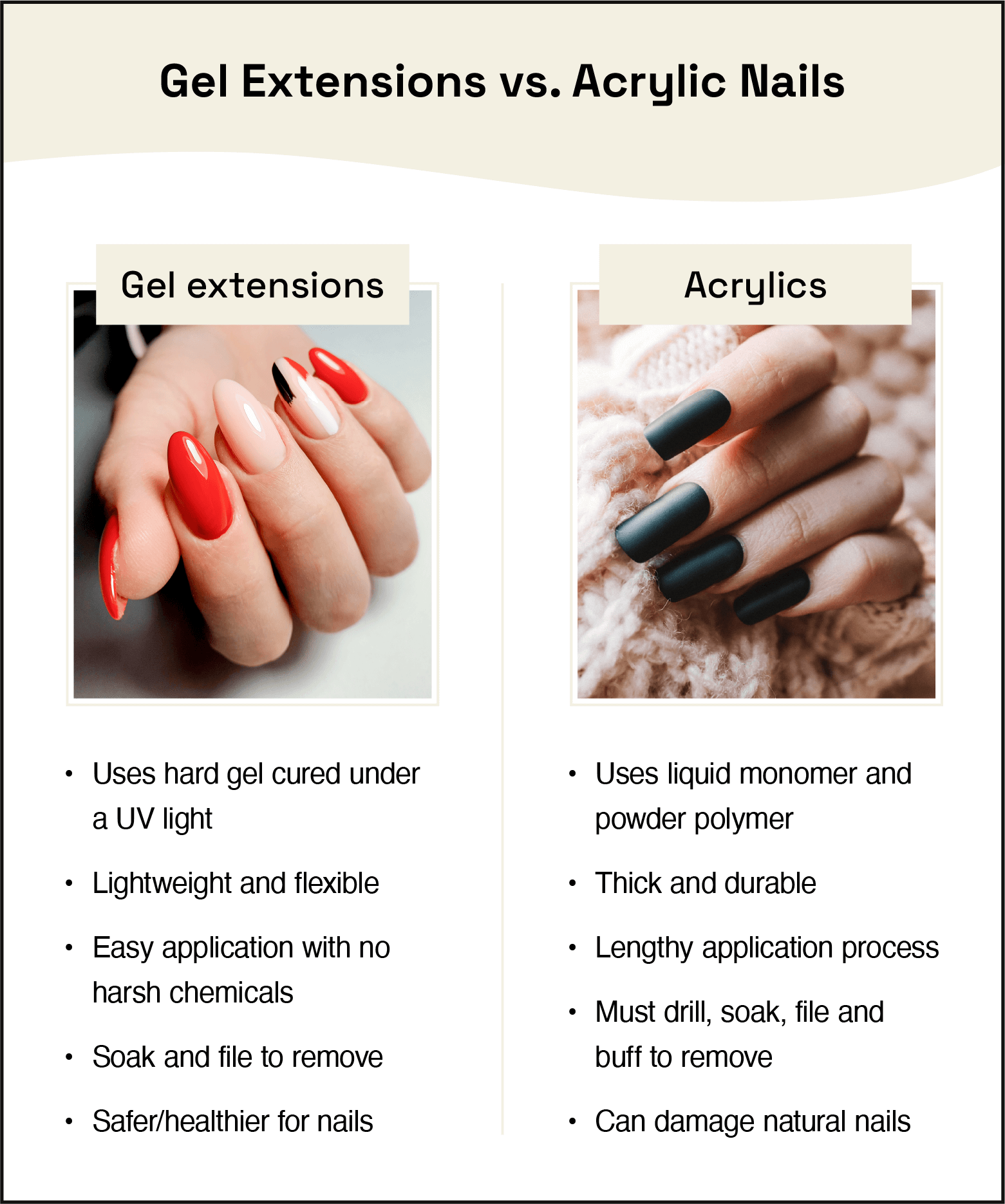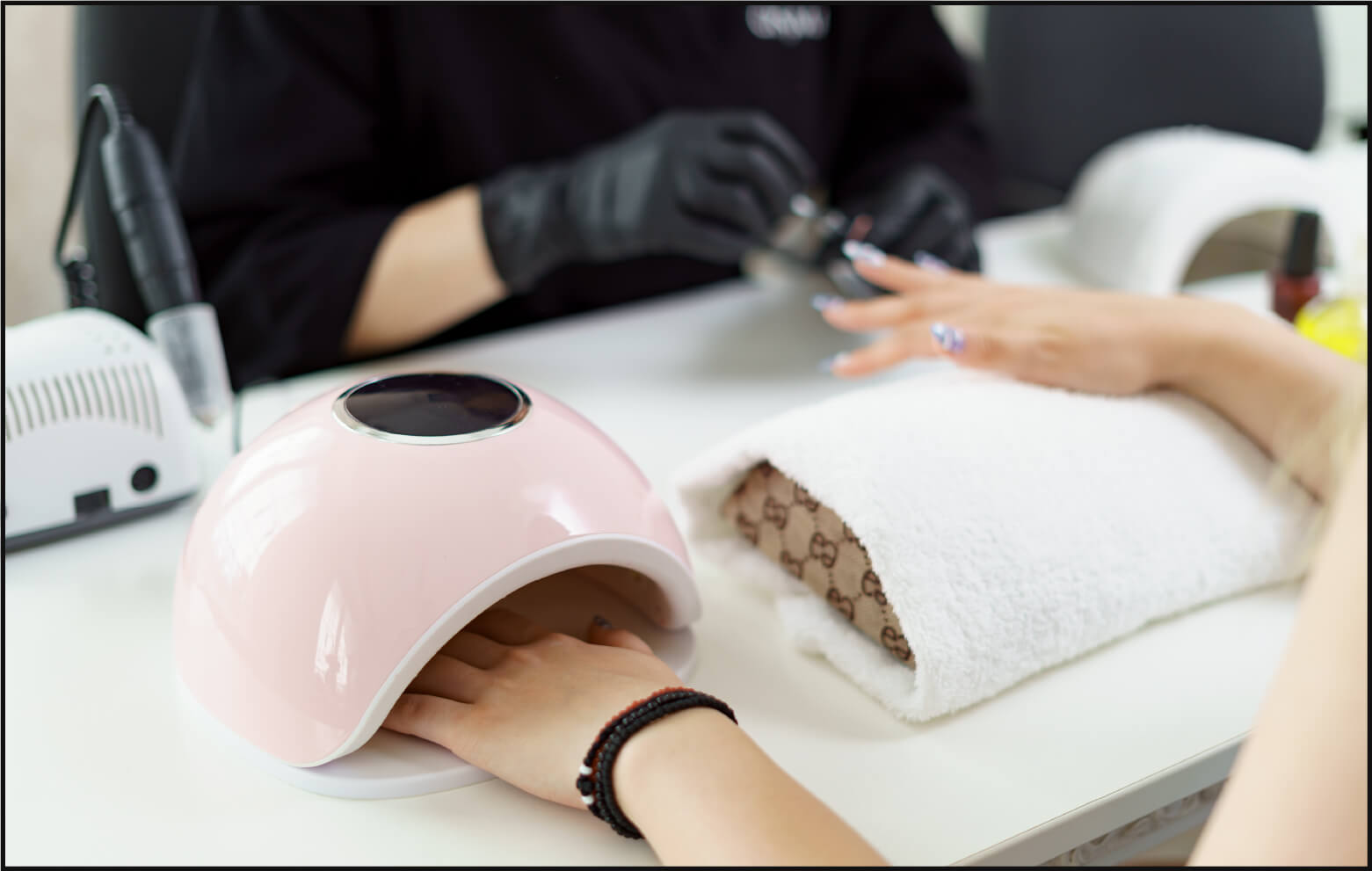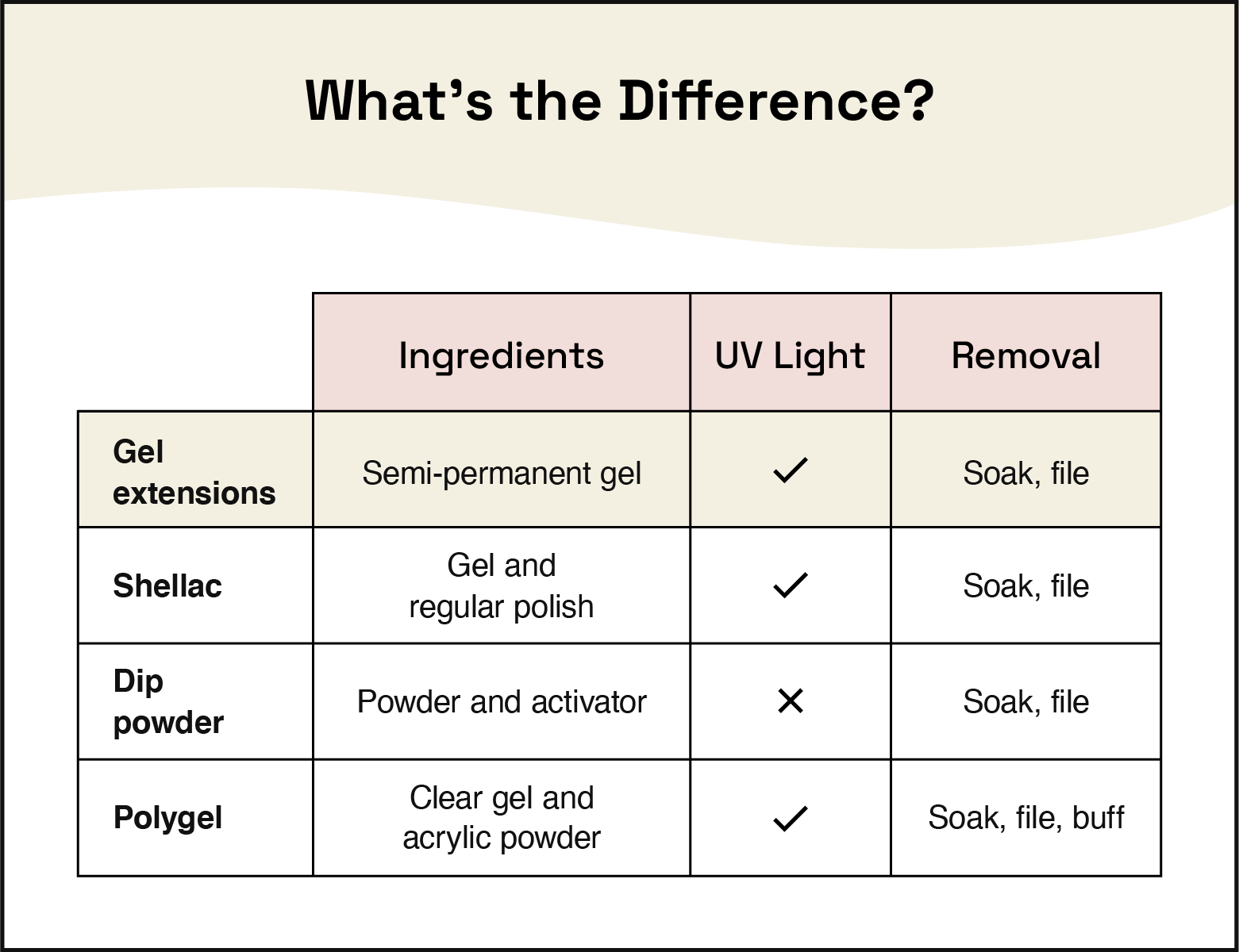Gel extensions are one of the most popular manicures nowadays, and the best part is that you don’t have to sacrifice your natural nails. They’re a great way to lengthen your nails, make them stronger, and have plenty of room for gorgeous designs — what’s not to love?
Both lightweight and durable, these nails should be your go-to if you want extensions without damaging your nail beds. Keep reading to learn all you need to know about how gel nail extensions work, how they differ from other nail treatments, and how much they cost.
What are gel extensions?
Gel extensions add length to your natural nail with hard gel. The process involves a technician extending the length of your nails using nail forms. These are adhesive stickers applied to the nail beds that act as a temporary base for product. Once the forms are in place, a hard gel is applied on top and cured with a UV light to create extensions that are light, flexible, and durable. After the nail is built, the adhesive form is removed.
Because of their lightweight nature, gel extensions are a great alternative to more damaging nail treatments like acrylics. The application process is simpler overall and doesn’t require any harsh chemicals. Before booking an appointment, you’ll just need to make sure that your natural nails have a little bit of length so the extensions have something to adhere to.

Pros
- Lightweight and flexible
- Easy application and removal process
- Less damaging to natural nails
Cons
- Requires some length on your natural nail to apply
- Less durable than other options like acrylics
- Can weaken your nails over time
What’s the difference between gel extensions and acrylics?
Both gel and acrylic can be used to create nail extensions, but the main difference is how they’re applied. Gel extensions use a cured hard gel to extend the nail, while acrylics use liquid monomer and powder polymer.
The finished result is similar, but because gel is a softer ingredient than acrylic, gel extensions tend to be lighter and more flexible. Less product is required to build up the natural nail, resulting in a more natural look than thick acrylic nails.
When it comes to application, gel extensions are easier and less of a hassle. Because there are no harsh chemicals involved, they have the added benefit of being less damaging to your natural nails. To remove gel extensions, you’ll only need to soak and file them, while acrylics require a lengthy process of drilling, soaking, filing, and buffing, which can weaken your nails over time.

How are these extensions applied?
Before starting the application process, your nail technician should look at your nails to determine if they’re long enough for gel extensions. If they’re too short, they will likely suggest another type of nail enhancement that’s a better fit for you.
You’ll be asked to wash your hands before the tech preps your nails by filing, buffing, and trimming your cuticles.
From there, they’ll apply bonder and primer to your natural nails. To extend the length of the nails, a form or sticker is pressed onto the natural nail before gel polish is applied. To complete the process, your technician will apply a gel top coat to give your nails some shine and help them last longer.
How long do gel nail extensions take?
Applying gel extensions is relatively simple, but you should still expect to spend at least an hour at the salon. Depending on the length, shape, and design you want, the process from start to finish could take anywhere from one to two hours. A good nail tech will take their time ensuring your extensions are applied correctly so they last as long as possible.
How long do gel nail extensions last?

Gel extensions generally last two to three weeks, but may even last up to four depending on how well you maintain them. Once they’ve grown out, you can book an appointment for a fill so they last longer instead of paying for a new set.
Because hard gel is very strong, you can rest assured that your extensions will last if you take care of them. As long as they’re applied properly, they shouldn’t break easily. However, if the application process is rushed, they will be more likely to break and may not last as long as you’d like.
Can I apply gel nail extensions at home?
If you don’t feel like going to a salon, you can apply gel extensions at home with the right supplies. To do so, follow the same process as a nail technician would:
- Prep the nails by filing and buffing.
- Apply bonder and primer.
- Attach the nail forms to your natural nails.
- Cut to your desired length.
- Finish off with a gel polish and top coat.
Applying your own gel extensions is definitely possible, but the results might not be as good as if you went to a professional. There’s also the potential that they won’t last as long.
How do I remove gel nail extensions?
To remove gel extensions, the nail technician will partially file them down and soak off the remaining gel in acetone for 15-20 minutes. Then it’s just a matter of gently scraping the product away. The removal process won’t take any longer than 40 minutes.
While it’s possible to remove gel extensions at home, it’s recommended to have them professionally removed in a salon. This is because failing to remove them properly can be detrimental to the health of your nails, and with a professional, damage is less likely to occur. If you decide to remove your extensions yourself, be patient and avoid the urge to rip them off quickly.
How much do gel nail extensions cost?
Depending on your desired result, you can expect to pay between $32 and $93 for a full set of gel nail extensions. There are several factors that can influence the final cost of your appointment, including:
- Complexity of design: A single-color polish will cost less than an intricate design requiring a lot of skill to achieve.
- Type of salon: Salons specializing in nail enhancements usually charge more for their expertise.
- Salon location: Living in an area with a high cost of living or high demand for gel extensions can increase price.
- Technician’s expertise: Technicians with more experience and skill often charge a higher rate.
- Technician’s tip: It’s encouraged to tip at least 20 percent of the total cost of service if you’re satisfied with the results.
It’s important to know the length, shape, color, and design you want beforehand since these can all contribute to the final cost. While the average cost for gel extensions across the U.S. is $58, prices vary between states and different salons. Gel nail extensions generally cost more than regular gel nails.
How do gel nail extensions compare to other nail treatments?
There are a variety of nail enhancements available, each with their own pros and cons. Some are more flexible while others are more durable and long-lasting. Before getting gel extensions, it’s important to understand how they compare to other types of popular manicures.

Gel nail extensions vs. shellac (gel polish)
While these nail enhancements may sound nearly identical, they have a few differences. Gel extensions use a semi-permanent gel, while shellac uses a combination of gel and regular polish. Just like gel extensions, each layer is cured with a UV or LED light.
The removal process is the same, but since shellac nails are partially regular polish, they tend to be easier to remove. As a result, they usually aren’t as long-lasting as gel extensions.
Gel nail extensions vs. dip powder
Dip nail extensions are applied with similar steps, but use a powder instead of gel. They typically don’t need to be cured with a UV light, but some may require it depending on the top coat used. If your natural nails are prone to chipping, dip powder can be a longer-lasting option compared to gel extensions.
The removal process is also similar. Both hard gel and dip powder will need to be filed down by a nail tech and then soaked in acetone.
Gel nail extensions vs. polygel
While gel nail extensions can be very strong when applied properly, polygel nails are even more durable. Polygel nails are created with a formulation of clear gel and acrylic powder and then cured with a UV light.
Because of their durability, polygel nails require more time and effort to remove. You’ll need to see your nail tech and go through a process of soaking, filing, and buffing.
How do I know I’m getting a safe service?
Nail enhancements come with risks if applied or removed improperly. While gel nail extensions are less harsh than popular acrylics, they can still be damaging to your nail beds. They have the potential to weaken your nails over time, making them more brittle and prone to breakage.
The key to minimizing damage is choosing a reputable nail technician. Not only should they have a history of good reviews, but they should also have a clean work station and use only sterilized tools.
A great way to find a professional nail tech is by getting recommendations from trusted friends and family before booking your appointment. It’s also helpful to check out their business profile for before and after photos from previous clients. This will give you an idea of their experience and whether they have the level of skill needed to achieve the results you desire.
If you want longer nails but would rather avoid harsh acrylics, gel extensions might be for you. This type of enhancement is quickly growing in popularity — and for good reason! Now that you know everything you need to know about gel extensions, browse our directory of nail technicians to find a professional to help you get your dream gel extensions.






